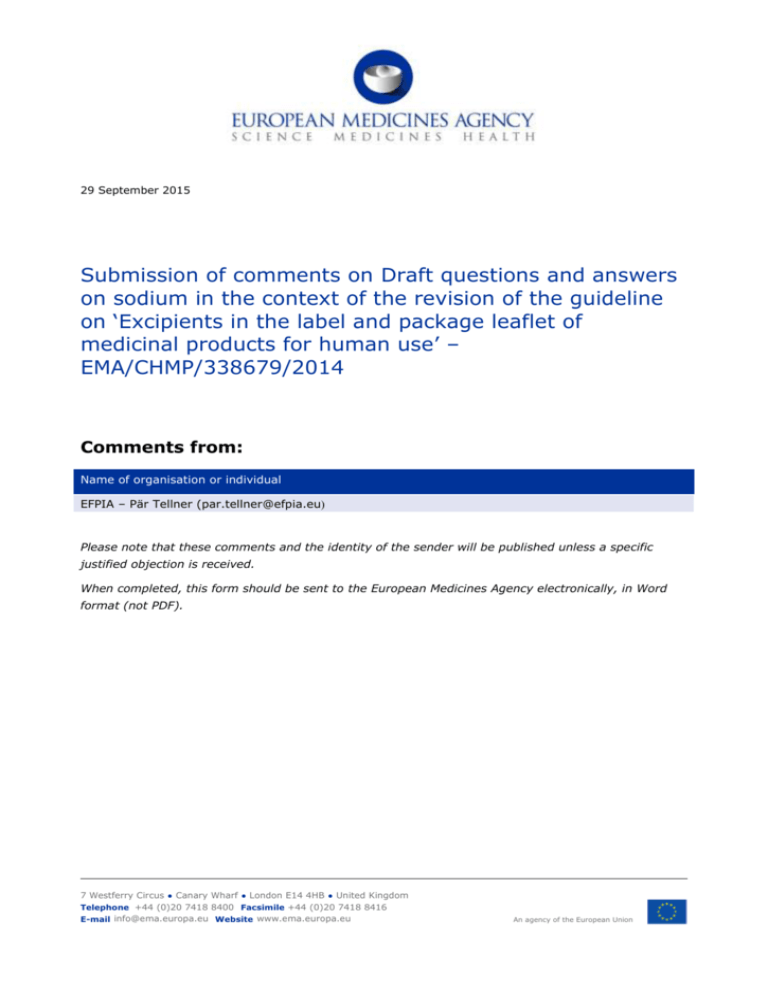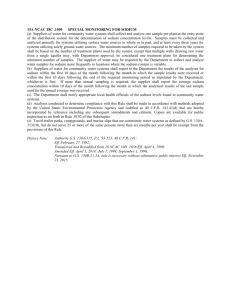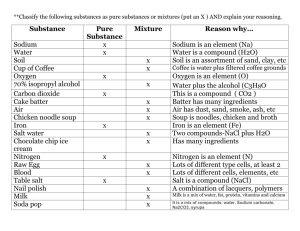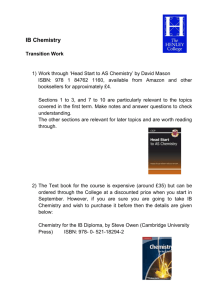Form for submission of comments
advertisement

29 September 2015 Submission of comments on Draft questions and answers on sodium in the context of the revision of the guideline on ‘Excipients in the label and package leaflet of medicinal products for human use’ – EMA/CHMP/338679/2014 Comments from: Name of organisation or individual EFPIA – Pär Tellner (par.tellner@efpia.eu) Please note that these comments and the identity of the sender will be published unless a specific justified objection is received. When completed, this form should be sent to the European Medicines Agency electronically, in Word format (not PDF). 7 Westferry Circus ● Canary Wharf ● London E14 4HB ● United Kingdom Telephone +44 (0)20 7418 8400 Facsimile +44 (0)20 7418 8416 E-mail info@ema.europa.eu Website www.ema.europa.eu An agency of the European Union 1. General comments Stakeholder number General comment (if any) (To be completed by Outcome (if applicable) (To be completed by the Agency) the Agency) It would be very helpful for users of the guidance to have all recommendations on product information text associated with sodium content to be stated in this Q&A document. Currently this Q&A relates to just Package Leaflet text (see Lines 118-119) whereas EMA/PRAC/234960/2015 makes recommendations for the SmPC and label also (p.7 Recommendation, from line 38). The Excipient Guideline also has ‘proposed SPC’ text stated in the ‘Comments’ column for certain excipients e.g. Glucose. See comment for line 163. It would be more relevant to physicians and patients if they were informed of the medicines’ total maximum daily dose of sodium (including main ingredient, excipient and diluent e.g. for infusions with sodium chloride solution), and not only excipient content; according to approved dosage recommendations and methods of administration in the SmPC, rather than having to do a calculation. Especially in an emergency situation. The need for immediately understandable information was highlighted in EMA/PRAC/234960/2015 (p.7 Recommendation, line 6). See comment for lines 156-157&163. For parenteral products which very often have body weight based dosing it is not always possible to estimate the amount of sodium per dose as it varies according to patient. It is difficult to define a common dose for products, which are administered via the parenteral routes and for medicinal products dosed according to the effect (for instance the insulin products, which are dosed 2/14 Stakeholder number General comment (if any) (To be completed by Outcome (if applicable) (To be completed by the Agency) the Agency) according the biomarkers, e.g. blood glucose). Should “dose “ be “<dose>” as is currently in the 2003 guideline so that in the above instance the amount of sodium per vial can be quoted instead? (See specific comments on line 163) Alternatively, it might be possible to rephrase the label text in the package leaflet to reflect the actual use, but labelling per vial is perhaps the more straightforward solution. Article 63(2) of Directive 2001/83/EC as well as the Guideline On The Readability Of The Labelling And Package Leaflet Of Medicinal Products For Human Use requires…that the package leaflet must be written to be clear and understandable, enabling the users to act appropriately. Therefore, the proposed labelling changes should be restricted to those medications, where the knowledge of the sodium content relative to the WHO recommendation could be of any use for a patient and she/he gets appropriate advice what should be done in her/his particular situation. Parenteral drugs are administered by Healthcare Professionals (HCPs) or administered following close advice from HCPs. The level of 17 mmol sodium will only be reached by infusions with a relatively large volume. In all these cases, sodium content is well considered by the HCPs; additional information beyond the current labelling may not provide any useful information to patients and could confuse the patient. For oral preparations it should be clarified, that the additional warning for medicinal products containing >17 mmol of sodium only has to be added, if the drug is intended for regular/long term use and the definition of this terms (as given in the running text of the Q&A paper) should be added in the table. 3/14 Stakeholder number General comment (if any) (To be completed by Outcome (if applicable) (To be completed by the Agency) the Agency) Drugs which have a clear restriction of duration of use in the label should be exempted in general, consequently also OTC analgesics, as they are restricted to short term use and not intended to treat chronic conditions. For products containing > 1 mmol < 17 mmol the patient will receive the information: “one dose of this medicinal product contains <x mg> sodium (found in table salt). This is equivalent to <y%> of the recommended maximum daily intake of sodium for an adult” even if the product is taken for a short period of time. The consequence to be taken by the patient is unclear as no further advice is given. What should an otherwise healthy patient do if she/ he takes such a product for a short period of time (e.g. during a common cold)? The wording of the 2003 Guideline provided more information: “To be taken into consideration by patients on a controlled sodium diet.” To meet the requirements of Article 63(2) of Directive 2001/83/EC it should be clarified that only regular/ long term use has to be considered and the former wording of the 2003 Guideline should be maintained for the package leaflet. A concern relates to the lack of a definitive value for the paediatric population. Where a medicine is developed for exclusive use in children, the proposed information on the label is not particularly helpful to the parent/carer and may lead to more rather than less confusion. 4/14 2. Specific comments on text Line number(s) of the relevant text (e.g. Lines 20- Stakeholder number Comment and rationale; proposed changes Outcome (To be completed by (If changes to the wording are suggested, they should (To be completed by the Agency) the Agency) be highlighted using 'track changes') 23) 29-30 Comment: It would be helpful to the reader to have all key information (i.e. when the Q&A takes affect) contained within the Q&A rather than having to toggle between webpages. Proposed change (if any): ‘When one or several Q&As have been finalised, the new information in the product information will be included in a revised annex of the guideline. The new product information text, translated into all EU languages will be applicable only when included in the revised Annex.’ 37-39 Comment: 37 -39 paragraph states that if sodium is the main ingredient of the medicine, it is out of scope of this Q&A. See general comment relating to maximising utility of information for HCP/patients. See also comment on lines 156-157 & 163 relating to recommendations from EMA/PRAC/234960/2015 stating the new threshold includes active and/or excipient content. See also general comment relating to inclusion of contribution from diluent e.g. sodium chloride solution solution. Proposed change (if any): ‘Sodium is used in medicines both as the main ingredient (for example where medicines are intended to replace physiological sodium, or the active pharmaceutical ingredient is a sodium salt), or in the preparation of the medicine prior to administration e.g. dissolution in sodium chloride solution 5/14 Line number(s) of the relevant text (e.g. Lines 20- Stakeholder number Comment and rationale; proposed changes Outcome (To be completed by (If changes to the wording are suggested, they should (To be completed by the Agency) the Agency) be highlighted using 'track changes') 23) prior to infusion, and also as an excipient. The former is out of scope of this Q&A. The threshold limits and information for the physician and patient in the product information take into consideration the total dose of sodium taken with the medicine prior to administration.’ 156-157 163 Comment: The threshold for sodium content of 20% of the WHO recommended maximum daily intake for sodium is based on content from active and/or excipients (see EMA/PRAC/234960/2015 Recommendation p.7 line 15-16). The Excipient guideline thresholds are, except where otherwise stated, expressed as Maximum Daily Doses of the excipient only. As appropriate the preparation for the medicine prior to administration e.g. dissolved in sodium chloride solution should be considered, together with duration and frequency of administration. Proposed change (if any): Additional text to add as appropriate to column ‘Information for the Package Leaflet’. - For proposed revisions to the table, as presented in this comments table, refer to the last page of this document: ‘<After dilution for use,>’ Additional text as a footnote to this row for ‘Sodium’: ‘Sodium threshold relates to total content of sodium e.g. from active ingredient, excipients and any diluent required in the 6/14 Line number(s) of the relevant text (e.g. Lines 20- Stakeholder number Comment and rationale; proposed changes Outcome (To be completed by (If changes to the wording are suggested, they should (To be completed by the Agency) the Agency) be highlighted using 'track changes') 23) SmPC prior to administration.’ For the ≥ 17mmol threshold comment column: ‘As a general guidance, this threshold applies to long term use or regular exposure where long term use is to be considered as continuous daily use for > 1 month and regular exposure is to be considered repeated use for more than 2 days every week.’ 160-161 Comment: The frequency and duration of administration should be added. (See EMA/PRAC/234960/2015, p.7 from line 24) Proposed change (if any): ‘…salt in their diet. The criteria for formulations that warrant update of the product information are: ≥ 17mmol sodium in the maximum daily dose, and are for long term use and regular exposure. As a general guidance, long term use is to be considered as continuous daily use for > 1 month and regular exposure is to be considered repeated use for more than 2 days every week.’ 163 Comment: Current wording could be made more patient friendly. Text related to mmol sodium amended to make it consistent with the 1 mmol and 17 mmol thresholds. Proposed change: This medicinal product One dose of this medicine contains less than 1 mmol sodium (23 mg) sodium (found in table salt)per <dose>, i.e. it is essentially ‘sodium- free’. 163 Comment: Current wording could be made more patient friendly. 7/14 Line number(s) of the relevant text (e.g. Lines 20- Stakeholder number Comment and rationale; proposed changes Outcome (To be completed by (If changes to the wording are suggested, they should (To be completed by the Agency) the Agency) be highlighted using 'track changes') 23) Proposed change: One dose of this medicinal product medicine contains <x mg> sodium (found in table salt). This is equivalent to <Y%> of the recommended maximum daily intake of sodium for an adult. 163 Comment: Current wording could be made more patient friendly. Proposed change: The maximum recommended daily dose of this medicinal product medicine contains <X mg> sodium (found in table salt). This is equivalent to <Y%> of the recommended maximum daily intake of sodium for an adult. 163 Talk to your pharmacist <doctor> <or> doctor <pharmacist> if <you> <or> <your child> need(s) [product name] on a daily basis for a prolonged period of time, especially if <you> <they> have been advised to follow a low sodium (salt) diet. Comment: Propose addition of WHO sodium DDI to assist with the inclusion of the % DDI sodium for the 1 mmol and 17 mmol thresholds. Proposed change: The WHO recommended maximum daily dietary intake for sodium is 2 g/day (equivalent to 5 g/day of table salt). 17 mmol (391 mg) is approximately 20% of the WHO adult recommended maximum daily dietary intake for sodium and is considered to represent ‘high’ sodium. 163 “...This is also relevant for children, where the maximum daily intake is considered to be proportional to adults and based on 8/14 Line number(s) of the relevant text (e.g. Lines 20- Stakeholder number Comment and rationale; proposed changes Outcome (To be completed by (If changes to the wording are suggested, they should (To be completed by the Agency) the Agency) be highlighted using 'track changes') 23) energy requirements...” 163 (Row 1 Table on Page 7) It may be more helpful to parents/carers to have definitive values for children, particularly for medicines developed for exclusive use in the paediatric population. Comment: As stated in the general comment for parenteral products which very often have body weight based dosing it is not always possible to estimate the amount of sodium per dose as it varies according to patient. Should “dose “ be stated as “<dose>” as is currently in the 2003 guideline so that in the above instance the amount of sodium per vial can be quoted. Proposed Change (marked in red) under the column with the heading “Threshold*”: Less than 1mmol per <dose> 163 (Row 2 Table on Page 7) Comment: As stated in the general comment for parenteral products which very often have body weight based dosing it is not always possible to estimate the amount of sodium per dose as it varies according to patient. Should “dose “ be stated as “<dose>” as is currently in the 2003 guideline so that in the above instance the amount of sodium per vial can be quoted. Proposed Changes (marked in red) under the column with the heading “Threshold*”: 1 mmol (23 mg) per <dose> 163 (Table on Page 7) Comment: There is a clear guidance given when the product contains less than 1mmol sodium per dose, for ‘parenteral’ route of administration with a statement that needs to be included in 9/14 Line number(s) of the relevant text (e.g. Lines 20- Stakeholder number Comment and rationale; proposed changes Outcome (To be completed by (If changes to the wording are suggested, they should (To be completed by the Agency) the Agency) be highlighted using 'track changes') 23) the package leaflet. For ‘oral’ products however, one may conclude that nothing needs to be reported regarding sodium on the label if the threshold is less than 1 mmol sodium per dose. There is no clear guidance given currently in the table. Proposed: Identify in the table by adding a new row for products with ‘oral’ route of administration with a sodium threshold of ‘less than 1 mmol per dose’. In this instance, if a statement is not required in the package leaflet it could be stated as ‘no statement is required for the leaflet’. 163 (Row 2Table on Page 7) Comment: Suggestions for improved clarity of the proposed package leaflet wording, when the threshold is 1 mmol (23 mg) per dose, in Oral and Parenteral route of administration. Rationale: “Table salt” is ambiguous. Patients may wonder if this also applies to cooking salt, rock salt or salt already in (processed) food. Proposed Text Changes (marked in red) for the column with the heading “Information for the Package Leaflet” : One dose of t This medicinal product contains <X mg> sodium (found in table salt) per <dose>. This amount is equivalent to <Y%> of the recommended maximum daily intake of sodium for an adult.”. 163 (Row 3- Comment: 10/14 Line number(s) of the relevant text (e.g. Lines 20- Stakeholder number Comment and rationale; proposed changes Outcome (To be completed by (If changes to the wording are suggested, they should (To be completed by the Agency) the Agency) be highlighted using 'track changes') 23) Table on Page 7) Suggestions for improved clarity of the proposed package leaflet wording, when the threshold is 17 mmol (391 mg) in the maximum daily dose, in Oral and Parenteral route of administration. Rationale: “Table salt” is ambiguous. Patients may wonder if this also applies to cooking salt, rock salt or salt already in (processed) food. Proposed Text Changes (marked in red) for the column with the heading “Information for the Package Leaflet”: The maximum recommended daily dose of this medicinal product contains <X mg> sodium (found in table salt). This amount is equivalent to <Y%> of the recommended maximum daily intake of sodium for an adult. Line 163-164 Comment: The proposed labelling changes could be restricted to those medications, where the knowledge of the sodium content relative to the WHO recommendation could be of any use for a patient (i.e. patients on a low sodium diet). Proposed change: Parenteral drugs Column 2 , Row 2+3 of table: Oral Add: 4th Row for “Parenteral” with the unchanged text from 2003 Guideline (columns 2-4): “Parenteral; 1 mmol (23 mg) per <dose>; This medicinal product contains x mmol (or y mg) sodium per dose. To be taken into consideration by patients on a controlled sodium diet.” Comment: The proposed labelling changes could be restricted to those medications, where the knowledge of the sodium content relative to the WHO recommendation could be of any 11/14 Line number(s) of the relevant text (e.g. Lines 20- Stakeholder number Comment and rationale; proposed changes Outcome (To be completed by (If changes to the wording are suggested, they should (To be completed by the Agency) the Agency) be highlighted using 'track changes') 23) use for a patient (i.e. patients on a low sodium diet). Proposed change: Oral drugs column 4, row 2 of table: “One dose of this medicinal product contains <X mg> sodium (found in salt). This is equivalent to <Y %> of the recommended maximum daily intake of sodium for an adult. Talk to your pharmacist or doctor if <you> <or> <your child> need(s) [product name] on a daily basis for a prolonged period of time, especially if <you> <they> have been advised to follow a low salt diet.” 163 - 165 Comment: The *note at the bottom of the table which states that ‘The threshold is a value, equal to or above which it is necessary to provide the information stated.’ is not sufficiently prominent. The sodium action thresholds should be displayed with the notes included. This is already the case for ethanol in the Annex of the guideline (page 9). The thresholds are displayed as 1) Less than 100mg per dose and 2) 100mg- 3g per dose, and 3) 3g per dose. Proposed change (if any): Threshold column: Less than 1mmol per dose 1 mmol (23 mg) per dose1 to x? mmol per dose Greater than or equal to 17 mmol (391 mg) in the maximum daily dose Delete footnote to table: ‘* Note: The threshold is a value, equal to or above which it is 12/14 Line number(s) of the relevant text (e.g. Lines 20- Stakeholder number Comment and rationale; proposed changes Outcome (To be completed by (If changes to the wording are suggested, they should (To be completed by the Agency) the Agency) be highlighted using 'track changes') 23) necessary to provide the information stated [1 ].’ Information on the package leaflet for less than 1 mmol per dose threshold: This medicinal product contains less than 1 mmol sodium (23 mg) per <dose>, i.e. it is essentially ‘sodium- free’ and can be used by people on a low sodium diet. Comment: The proposed labelling changes should be restricted to those medications that are intended for regular/long term use. Proposed change: Oral drugs Column 3, Row 3 of table: Add: “If according to labeled posology the product has to be taken on a daily basis for more than 1 month or repeated use for more than 2 days every week for more than 1 month.” 13/14 Line number(s) of the relevant text (e.g. Lines 20- Stakeholder number Comment and rationale; proposed changes Outcome (To be completed by (If changes to the wording are suggested, they should (To be completed by the Agency) the Agency) be highlighted using 'track changes') 23) 163 Comment concerning parenteral drugs containing less than 1 mmol per “dose” As mentioned in the comment above, mentioning that “This medicinal product contains less than 1 mmol sodium (23 mg) per <dose>, i.e. it is essentially `sodium-free.´ might potentially confuse the patients reading the package leaflet. HCPs always carefully advice their patients in how to use the medicines. Thus, the exact information about sodium content should only be included in the SmPC, as information to the HCPs, not in the package leaflet. It could be included in section 2 of the SmPC. The information in the package leaflet should be as short and yet informative as possible. Thus it is proposed just to write that “This medicine is “essentially `sodium-free´. This will avoid any patient confusion about sodium content. Furthermore, we do not agree to include the sentence “….and can be used by people on a low sodium diet” in the package leaflet, as this advice should be given by the HCPs, not the MAH. Please add more rows if needed. 14/14







